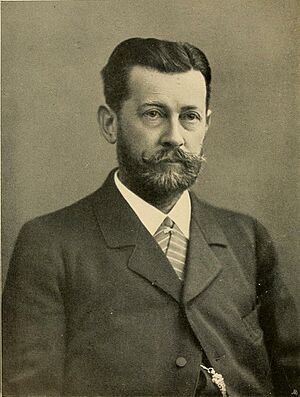Alfred Nehring facts for kids
Alfred Nehring (born January 29, 1845, in Gandersheim – died September 29, 1904, in Berlin-Charlottenburg) was a German zoologist and paleontologist. A zoologist studies animals, and a paleontologist studies ancient life, like fossils. He was one of the first professors of zoology at the Royal Agricultural University in Berlin.
Early Life and Career
Alfred Nehring was born in Gandersheim, Germany. He went to school in Helmstedt and Braunschweig, finishing his exams in 1863. He then studied at the University of Göttingen and earned his doctorate degree from Halle in 1867.
After his studies, he became a teacher. He taught at the Royal Gymnasium in Wesel starting in 1867, and later moved to Wolfenbüttel in 1871. His work on ancient animals (paleontology) caught the attention of other important scientists.
In 1881, Alfred Nehring became a professor of zoology. He taught at the new Royal Agricultural University in Berlin. He continued his research and teaching there until he passed away.
Scientific Discoveries
Nehring was very interested in animal fossils from the Ice Age, also known as the Pleistocene period. He studied fossils found in many different places across Germany. These included areas like Thiede, Immendorf, and Quedlinburg. He also looked at ancient deposits in Köchingen and Vollstedt.
His scientific work focused on both animals living today and those that lived long ago. He was especially curious about how domesticated animals, like horses and dogs, changed over time. He also studied their "morphology," which means the way their bodies are built and shaped.
For example, in his studies of the guinea pig, he believed that a wild species called Cavia cutleri was the direct ancestor of the guinea pigs we have as pets today.
Recognition
Alfred Nehring was a respected scientist. He became a member of the Leopoldina Academy, which is a famous German science organization. In 1895, he received an award called the Order of the Red Eagle, IVth Class, for his contributions.
Selected Writings
Alfred Nehring wrote many scientific papers and books during his career. His writings covered a wide range of topics about animals and fossils. Some of his notable works included studies on:
- Ueber Tundren und Steppen der jetzt- und vorzeit, mit besonderer Berücksichtigung ihrer Fauna, 1890 – This book was about tundra and steppe environments, both past and present, and the animals that lived in them.
- Die geographische Verbreitung der Säugetiere in dem Tschernosem-Gebiete des rechten Wolgaufers, sowie in den angrenzenden Gebieten, 1891 – This work discussed where different mammals live in the Chernozem regions near the Volga River.
- Ueber Kreuzungen von Cavia aperea und Cavia cobaya, 1893 – This paper explored the crossbreeding of different types of guinea pigs.
Nehring also helped with a famous book called Das Totenfeld von Ancon in Peru by Reiss and Stübel. This book was about the ancient burial site of Ancon in Peru and taught us about the culture of the Incas.


